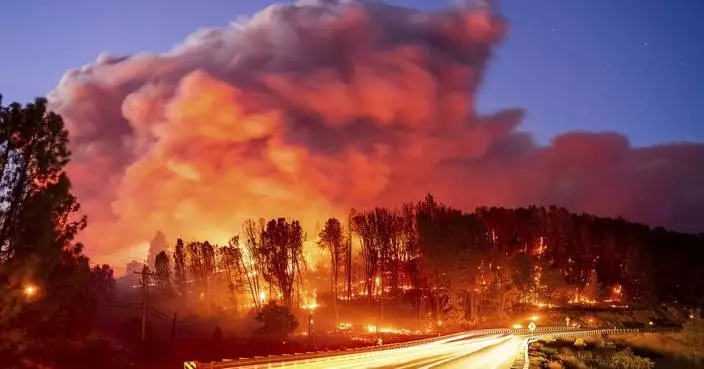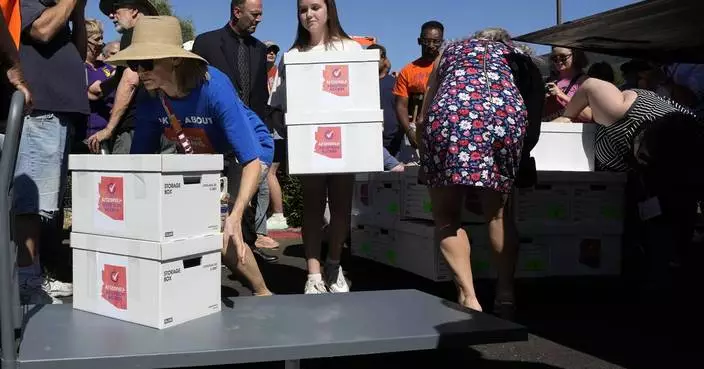NEW YORK (AP) — The “miners” who chisel bitcoins out of complex mathematics are taking a 50% pay cut — effectively reducing new production of the world’s largest cryptocurrency, again.
Bitcoin's latest “halving" occurred Friday night. Soon after the highly anticipated event, the price of bitcoin held steady at about $63,907.
Now, all eyes are on what will happen down the road. Beyond bitcoin’s long-term price behavior, which relies heavily on other market conditions, experts point to potential impacts on the day-to-day operations of the asset’s miners themselves. But, as with everything in the volatile cryptoverse, the future is hard to predict.
Here’s what you need to know.
Bitcoin “halving,” a preprogrammed event that occurs roughly every four years, impacts the production of bitcoin. Miners use farms of noisy, specialized computers to solve convoluted math puzzles; and when they complete one, they get a fixed number of bitcoins as a reward.
Halving does exactly what it sounds like — it cuts that fixed income in half. And when the mining reward falls, so does the number of new bitcoins entering the market. That means the supply of coins available to satisfy demand grows more slowly.
Limited supply is one of bitcoin’s key features. Only 21 million bitcoins will ever exist, and more than 19.5 million of them have already been mined, leaving fewer than 1.5 million left to pull from.
So long as demand remains the same or climbs faster than supply, bitcoin prices should rise as halving limits output. Because of this, some argue that bitcoin can counteract inflation — still, experts stress that future gains are never guaranteed.
Per bitcoin’s code, halving occurs after the creation of every 210,000 “blocks” — where transactions are recorded — during the mining process.
No calendar dates are set in stone, but that divvies out to roughly once every four years.
Only time will tell. Following each of the three previous halvings, the price of bitcoin was mixed in the first few months and wound up significantly higher one year later. But as investors well know, past performance is not an indicator of future results.
“I don’t know how significant we can say halving is just yet,” said Adam Morgan McCarthy, a research analyst at Kaiko. “The sample size of three (previous halvings) isn’t big enough to say ‘It’s going to go up 500% again,’ or something.”
At the time of the last halving in May 2020, for example, bitcoin’s price stood at around $8,602, according to CoinMarketCap — and climbed almost seven-fold to nearly $56,705 by May 2021. Bitcoin prices nearly quadrupled a year after July 2016’s halving and shot up by almost 80 times one year out from bitcoin’s first halving in November 2012. Experts like McCarthy stress that other bullish market conditions contributed to those returns.
Friday's halving also arrives after a year of steep increases for bitcoin. As of Friday night, bitcoin’s price stood at $63,907 per CoinMarketCap. That’s down from the all-time-high of about $73,750 hit last month, but still double the asset’s price from a year ago.
Much of the credit for bitcoin’s recent rally is given to the early success of a new way to invest in the asset — spot bitcoin ETFs, which were only approved by U.S. regulators in January. A research report from crypto fund manager Bitwise found that these spot ETFs, short for exchange-traded funds, saw $12.1 billion in inflows during the first quarter.
Bitwise senior crypto research analyst Ryan Rasmussen said persistent or growing ETF demand, when paired with the “supply shock” resulting from the coming halving, could help propel bitcoin’s price further.
“We would expect the price of Bitcoin to have a strong performance over the next 12 months,” he said. Rasmussen notes that he’s seen some predict gains reaching as high as $400,000, but the more “consensus estimate” is closer to the $100,000-$175,000 range.
Other experts stress caution, pointing to the possibility the gains have already been realized.
In a Wednesday research note, JPMorgan analysts maintained that they don’t expect to see post-halving price increases because the event “has already been already priced in” — noting that the market is still in overbought conditions per their analysis of bitcoin futures.
Miners, meanwhile, will be challenged with compensating for the reduction in rewards while also keeping operating costs down.
“Even if there’s a slight increase in bitcoin price, (halving) can really impact a miner’s ability to pay bills,” Andrew W. Balthazor, a Miami-based attorney who specializes in digital assets at Holland & Knight, said. “You can’t assume that bitcoin is just going to go to the moon. As your business model, you have to plan for extreme volatility.”
Better-prepared miners have likely laid the groundwork ahead of time, perhaps by increasing energy efficiency or raising new capital. But cracks may arise for less-efficient, struggling firms.
One likely outcome: Consolidation. That’s become increasingly common in the bitcoin mining industry, particularly following a major crypto crash in 2022.
In its recent research report, Bitwise found that total miner revenue slumped one month after each of the three previous halvings. But those figures had rebounded significantly after a full year — thanks to spikes in the price of bitcoin as well as larger miners expanding their operations.
Time will tell how mining companies fare following this latest halving. But Rasmussen is betting that big players will continue to expand and utilize the industry’s technology advances to make operations more efficient.
Pinpointing definitive data on the environmental impacts directly tied to bitcoin halving is still a bit of a question mark. But it’s no secret that crypto mining consumes a lot of energy overall — and operations relying on pollutive sources have drawn particular concern over the years.
Recent research published by the United Nations University and Earth’s Future journal found that the carbon footprint of 2020-2021 bitcoin mining across 76 nations was equivalent to emissions of burning 84 billion pounds of coal or running 190 natural gas-fired power plants. Coal satisfied the bulk of bitcoin’s electricity demands (45%), followed by natural gas (21%) and hydropower (16%).
Environmental impacts of bitcoin mining boil largely down to the energy source used. Industry analysts have maintained that pushes towards the use of more clean energy have increased in recent years, coinciding with rising calls for climate protections from regulators around the world.
Production pressures could result in miners looking to cut costs. Ahead of the latest halving, JPMorgan cautioned that some bitcoin mining firms may “look to diversify into low energy cost regions” to deploy inefficient mining rigs.

FILE - An advertisement for the cryptocurrency Bitcoin displayed on a tram, May 12, 2021, in Hong Kong. Sometime in the next few days or even hours, the “miners” who chisel bitcoins out of complex mathematics are going to take a 50% pay cut — effectively slicing new emissions of the world’s largest cryptocurrency in an event called bitcoin halving. (AP Photo/Kin Cheung, File)
WEST PALM BEACH, Fla. (AP) — Israeli Prime Minister Benjamin Netanyahu worked to mend ties with Republican presidential candidate Donald Trump on Friday and offered measured optimism about progress toward a cease-fire deal for Gaza as he neared the end of a contentious U.S. visit that put on display the growing American divisions over support for the Israeli-Hamas war.
At Trump's Florida Mar-a-Lago estate, where the two men met face-to-face for the first time in nearly four years, Netanyahu told journalists he wanted to see U.S.-mediated talks succeed for a cease-fire and release of hostages.
“I hope so,” Netanyahu said, when reporters asked if his U.S. trip had made progress. While Netanyahu at home is increasingly accused of resisting a deal to end the 9-month-old war to stave off the potential collapse of his far-right government when it ends, he said Friday he was "certainly eager to have one. And we’re working on it.”
As president, Trump went well beyond his predecessors in fulfilling Netanyahu’s top wishes from the United States. Yet relations soured after Netanyahu became one of the first world leaders to congratulate Joe Biden for his 2020 presidential victory, which Trump continues to deny.
The two men now have a strong interest in restoring their relationship, both for the political support their alliance brings and for the luster it gives each with their conservative supporters.
A beaming Trump was waiting for Netanyahu on the stone steps outside his private club and residence in Palm Beach, Florida. He warmly clasped the hands of the Israeli leader.
“We’ve always had a great relationship,” Trump insisted before journalists. Asked as the two sat down in a muraled room for talks if Netanyahu’s trip to Mar-a-Lago was repairing their bond, Trump responded, “It was never bad.”
For both men, Friday’s meeting was aimed at highlighting for their home audiences their depiction of themselves as strong leaders who have gotten big things done on the world stage, and can again.
Netanyahu’s Florida trip followed a fiery address to a joint meeting of Congress on Wednesday that defended his government’s conduct of the war and condemned American protesters galvanized by the killing of more than 39,000 Palestinians in the conflict.
On Thursday, Netanyahu had met in Washington with Biden and Vice President Kamala Harris, who appears on track to becoming the new Democratic presidential nominee after Biden decided to step out of the race. Both pressed the Israeli leader to work quickly to wrap up a deal to bring a cease-fire and release hostages held by Hamas.
Trump’s campaign said he pledged in Friday's meeting to “make every effort to bring peace to the Middle East” and combat antisemitism on college campuses if American voters elect him to the presidency in November.
Netanyahu handed Trump a framed photo that the Israeli leader said showed a child who has been held hostage by Hamas-led militants since the first hours of the war. “We’ll get it taken care of,” Trump assured him.
In a speech later Friday before a group of young Christian conservatives, Trump said he also asked Netanyahu during their meeting how “a Jewish person, or a person that loves Israel” can vote for Democrats.
He also laced into Harris for missing Netanyahu's speech and claimed she “doesn’t like Jewish people” and “doesn’t like Israel." Harris has been married to a Jewish man for a decade.
For Trump, the meeting was a chance to be cast as an ally and statesman, as well as to sharpen efforts by Republicans to portray themselves as the party most loyal to Israel.
Divisions among Americans over U.S. support for Israel’s war against Hamas in Gaza have opened cracks in years of strong bipartisan backing for Israel, the biggest recipient of U.S. aid.
For Netanyahu, repairing relations with Trump is imperative given the prospect that Trump may once again become president of the United States, which is Israel’s vital arms supplier and protector.
One gamble for Netanyahu is whether he could get more of the terms he wants in any deal on a Gaza cease-fire and hostage release, and in his much hoped-for closing of a normalization deal with Saudi Arabia, if he waits out the Biden administration in hopes that Trump wins.
“Benjamin Netanyahu has spent much of his career in the last two decades in tethering himself to the Republican Party,” said Aaron David Miller, a former U.S. diplomat for Arab-Israeli negotiations, now a senior fellow at the Carnegie Endowment for International Peace.
For the next six months, that means “mending ties with an irascible, angry president," Miller said, meaning Trump.
Netanyahu and Trump last met at a September 2020 White House signing ceremony for the signature diplomatic achievement of both men’s political careers. It was an accord brokered by the Trump administration in which the United Arab Emirates and Bahrain agreed to establish normal diplomatic relations with Israel.
For Israel, it amounted to the two countries formally recognizing it for the first time. It was a major step in what Israel hoped would be an easing of tensions and a broadening of economic ties with its Arab neighbors.
In public postings and statements after his break with Netanyahu, Trump portrayed himself as having stuck his neck out for Israel as president, and Netanyahu paying him back with disloyalty.
He also has criticized Netanyahu on other points, faulting him as “not prepared” for the Oct. 7 Hamas attacks that started the war in Gaza, for example.
In his high-profile speech to Congress on Wednesday and again Friday at Mar-a-Lago, Netanyahu poured praise on Trump, calling the regional accords Trump helped broker historic and thanking him “for all the things he did for Israel.”
Netanyahu listed actions by the Trump administration long-sought by Israeli governments — the U.S. officially saying Israel had sovereignty over the Golan Heights, captured from Syria during a 1967 war; a tougher U.S. policy toward Iran; and Trump declaring Jerusalem the capital of Israel, breaking with longstanding U.S. policy that Jerusalem's status should be decided in Israeli-Palestinian negotiations.
“I appreciated that,” Trump told “Fox & Friends” on Thursday, referring to Netanyahu's praise.
Trump has repeatedly urged that Israel with U.S. support “finish the job” in Gaza and destroy Hamas, but he hasn’t elaborated on how.
Natalie Melzer in Tel Aviv, Israel, Adriana Gomez Licon in West Palm Beach, Florida, and Jill Colvin in New York contributed. Knickmeyer reported from Washington. Price reported from New York.
Follow the AP's coverage of the 2024 election at https://apnews.com/hub/election-2024.
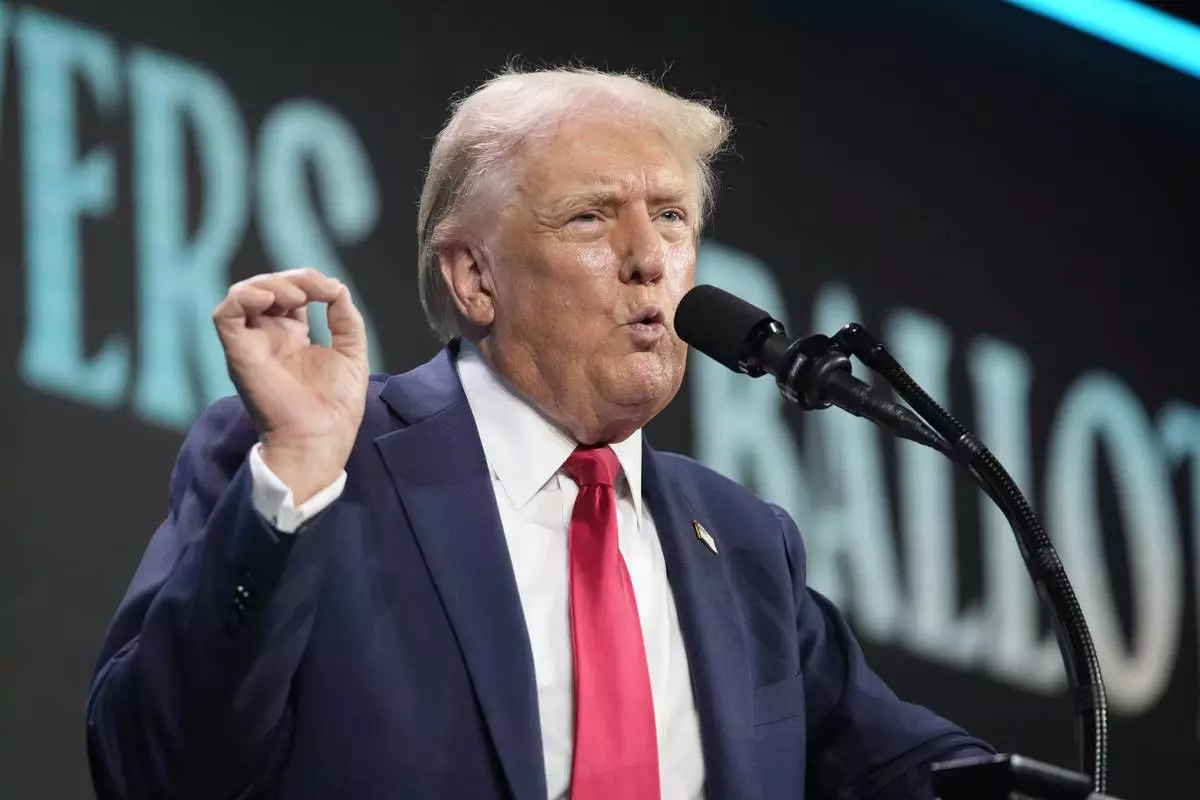
Republican presidential candidate former President Donald Trump speaks at the Turning Point Believers' Summit, Friday, July 26, 2024, in West Palm Beach, Fla. (AP Photo/Alex Brandon)

Republican presidential candidate former President Donald Trump listens as he meets with Israeli Prime Minister Benjamin Netanyahu at his Mar-a-Lago estate, Friday, July 26, 2024, in Palm Beach, Fla. (AP Photo/Alex Brandon)

Republican presidential candidate former President Donald Trump meets with Israeli Prime Minister Benjamin Netanyahu at his Mar-a-Lago estate, Friday, July 26, 2024, in Palm Beach, Fla. (AP Photo/Alex Brandon)
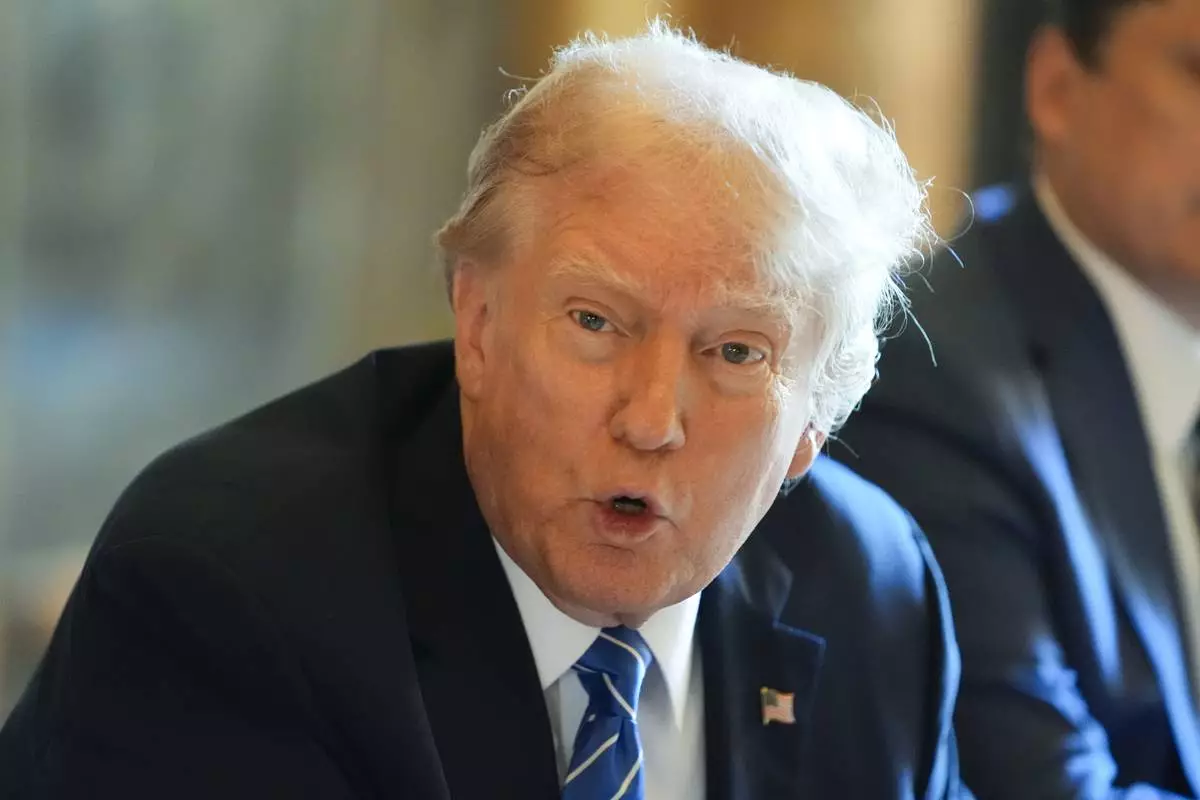
Republican presidential candidate former President Donald Trump speaks while meeting with Israeli Prime Minister Benjamin Netanyahu at his Mar-a-Lago estate, Friday, July 26, 2024, in Palm Beach, Fla. (AP Photo/Alex Brandon)
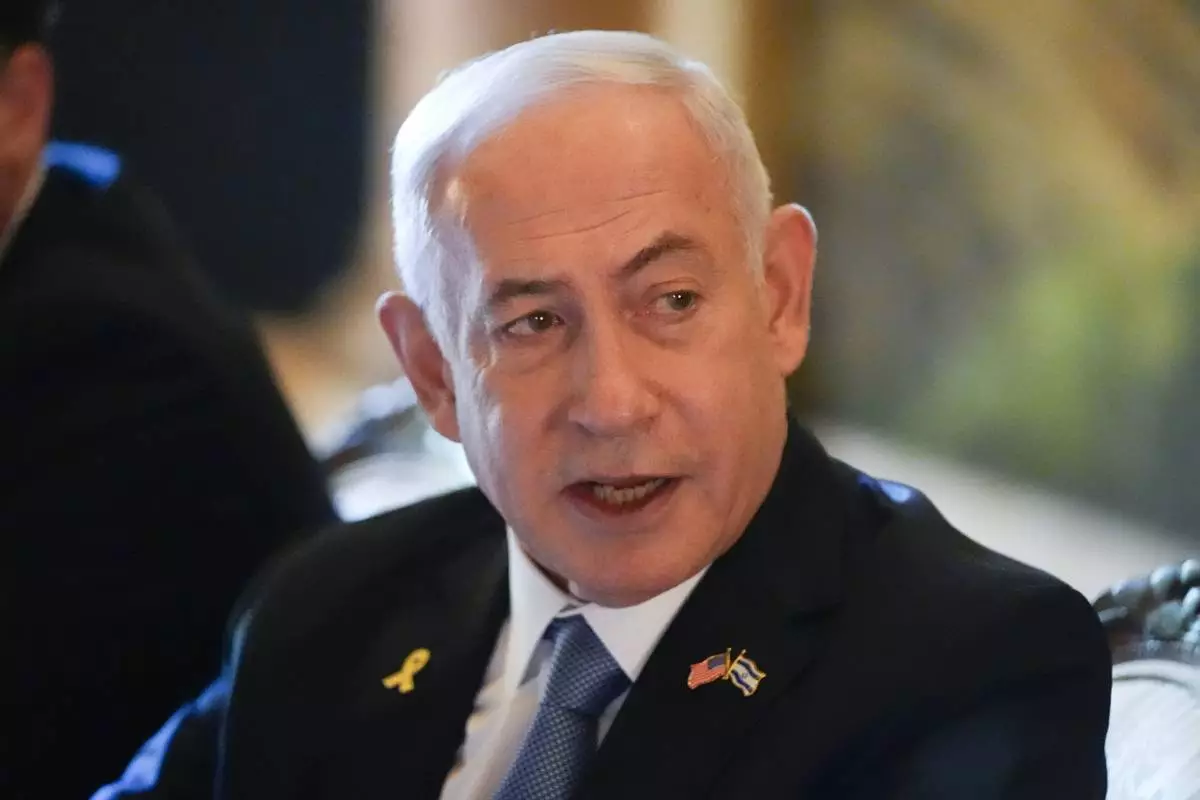
Israeli Prime Minister Benjamin Netanyahu speaks while meeting with Republican presidential candidate former President Donald Trump at his Mar-a-Lago estate, Friday, July 26, 2024, in Palm Beach, Fla. (AP Photo/Alex Brandon)

Republican presidential candidate former President Donald Trump meets with Israeli Prime Minister Benjamin Netanyahu, right, at his Mar-a-Lago estate, Friday, July 26, 2024, in Palm Beach, Fla. (AP Photo/Alex Brandon)

Republican presidential candidate former President Donald Trump meets with Israeli Prime Minister Benjamin Netanyahu at his Mar-a-Lago estate, Friday, July 26, 2024, in Palm Beach, Fla. (AP Photo/Alex Brandon)

Republican presidential candidate former President Donald Trump meets with Israeli Prime Minister Benjamin Netanyahu at his Mar-a-Lago estate, Friday, July 26, 2024, in Palm Beach, Fla. (AP Photo/Alex Brandon)

FILE - President Donald Trump, right, meets with Israeli Prime Minister Benjamin Netanyahu in the Oval Office, Sept. 15, 2020, at the White House in Washington. Trump is due to talk face-to-face with Netanyahu for the first time in nearly four years. The meeting Friday, July 26, 2024, at Mar-a-Lago will mend a break that has lasted since 2021. Trump at the time blasted Netanyahu for being one of the first leaders to congratulate President Joe Biden for his election victory. (AP Photo/Alex Brandon, File)

















